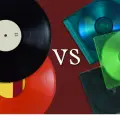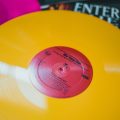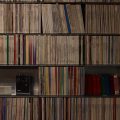Woah! What’s all the hubbub!? Not one moment ago, we were all listening to CD’s, what are these big black discs everyone seems to be raving about all of a sudden, what are vinyls?
Vinyl records are a form of analog sound storage that dates back to the early 20th century, becoming the primary medium for commercial music distribution until the late 1980s when digital media began to take over. They have seen a resurgence in popularity in recent years due to their warm sound quality and the tangible connection they offer to music.
A vinyl record is made from polyvinyl chloride (PVC) and is inscribed with a modulated spiral groove that starts near the outer edge and ends near the center of the disc. The grooves are tiny indentations that represent the sound’s analog waveforms. These grooves are created during the mastering process, where a master disc is cut using a lathe that etches the sound waveforms into a lacquer-coated aluminum disc. This master is then used to create stampers that will press the grooves into the vinyl records.
This vinyl boom does seem to have come from nowhere, especially if you have not been keeping an eye on the times as they pass us by, but the resurgence of vinyl makes perfect sense.
We live in a climate of nostalgia, for all things old and antiquated, and to me this seems as much in reaction to the difficulty of our own times as any other reason a scholar might suggest to the contrary.
The youth of today, faced with complexity of the present day, are looking for more and more ways to escape, to hark back to a time when things were supposedly simpler.
This is, of course, illusion, as these complexities have either always been (well hidden) or have otherwise been bubbling under the surface for sometime. Nevertheless, both vinyl and tape have seen a massive resurgence, which has done wonders for the more independent recording artists, especially in the wake of digital streaming.
So, without further ado, we embark on answering today’s seminal question: just what are vinyls?
Table of Contents
- The History of Vinyl
- What are Vinyls?
- What Are Vinyl Records Made Of?
- What Types of Records Are There?
- Final Tones
- FAQs What Are Vinyl Records
The History of Vinyl
Before we address “What are vinyls?” we must first look at the first proper conception of sound recording which dates back to vinyl or something very similar. In 1877, Thomas Edison invented the phonograph, a device that could record and play back sound in a very similar way to the vinyls we know today, though with the main difference being cylinders instead of discs. Through various permutations, this invention came closer to what we are presently aware of.
In 1889, Emile Berliner invented a way to realize recordings onto a flat disc, birthing the gramophone, a similar invention that played recorded discs through a large horn hand-cranked by the user in question. These discs were usually made with shellac, which paled in comparison with Edison’s sound quality, though this soon improved over time and various permutations of the form, with larger discs coming into existence to house longer lengths of music.
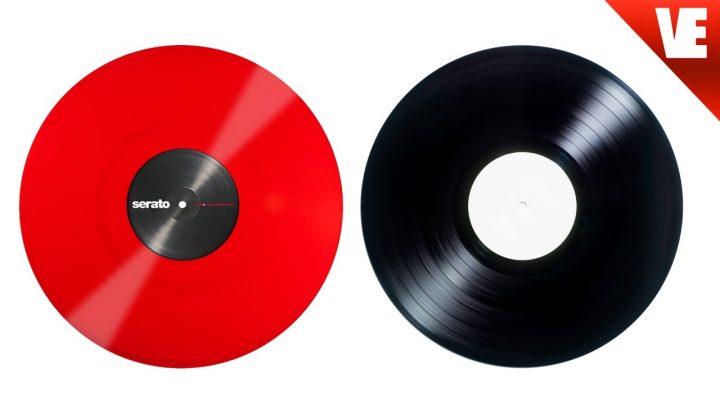
Eventually, in the 1940s, the so-called final form of records came around, when companies began making the records we know and love with polyvinyl chloride. Very little has changed since then really, aside from small changes in production and manufacture, but most music produced and printed onto these vinyl records is done so in very similar if not almost identical ways.
The main difference lies in the speed at which they are played, as well as the more widespread implementation of larger record discs like the 12-inch, which redefined the question ‘what are vinyls’. In the early days of recording technology, it was most common for a disc to be played on a gramophone at 78 rpm, as this is around what its original progenitor Emile Berliner recommended.
This has since fallen incredibly by the wayside. Though a faster speed means a higher quality of audio, it makes for far less space on the disc itself.
What are Vinyls?
Well, as should be somewhat obvious by now, vinyl records are just that! Artifacts of music recorded and captured, and then pressed onto vinyl discs for the consumption of whoever should choose to spend their hard-earned bucks on it.
The discs themselves are made from polyvinyl chloride heated to the point where it is malleable enough to be printed with whatever is so desired. These tend to be printed with a master disc, which has itself been printed from a master tape recording or some other such medium.
Vinyl recording is such an imperfect and bizarre medium that many allowances and factors have to be taken into account when mastering and mixing a song for this purpose.
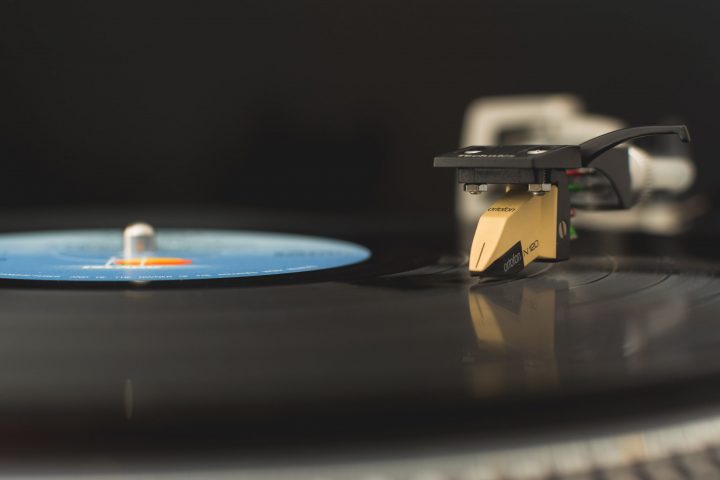
Once the record has been printed, then it is placed on the turntable, upon whose platter it spins and greets the stylus. This stylus transmits all of the fine detail and sensitive data from within the small and thin grooves into sound through the stereo system and speakers (or headphones if you are so inclined). Somehow the vinyl is printed in such a way that certain vibrations are transmitted through the stylus that can then be heard as music.
If this sounds particularly wild, it is because it indeed is. And yet, this used to be the common currency between music fans, the way that music enthusiasts enjoyed music at home and in clubs.
Of course, the various complications became too much and the vinyl record was superseded by other mediums, like the CD for instance. Yet, here we are still, judging the significance of this medium and asking once more, what are vinyls?
What Are Vinyl Records Made Of?
A vinyl record is made from polyvinyl chloride (PVC). This seminal and unavoidable material, polyvinyl chloride, is at its most simply produced through the combination of crude oil and chlorine, at the root of what are vinyls. Yes, the vinyl records that you know and love, or otherwise have come into contact with, are rather bad for the environment, crude for it in a very big way. Even the name itself is intense, no?
The name polyvinyl chloride might even feel somewhat familiar, even if you have not necessarily heard it in this guise before. A lot of plumbing and other things around the house (and elsewhere for that matter) are made with the very same material, though it is more often referred to as PVC. Sound familiar? I thought so.
In its original form, the chemical of polyvinyl chloride in its natural state is more or less completely clear, which, if you have paid attention to any Record Store Day releases in the last few years, makes for delightful opportunities for experimental color combinations.
If so, you will also have noticed that the most common color for vinyl records is still black. This will almost certainly be for financial reasons, to save record producers and pressers money throughout the process, this color likely being cheaper than most other alternatives.
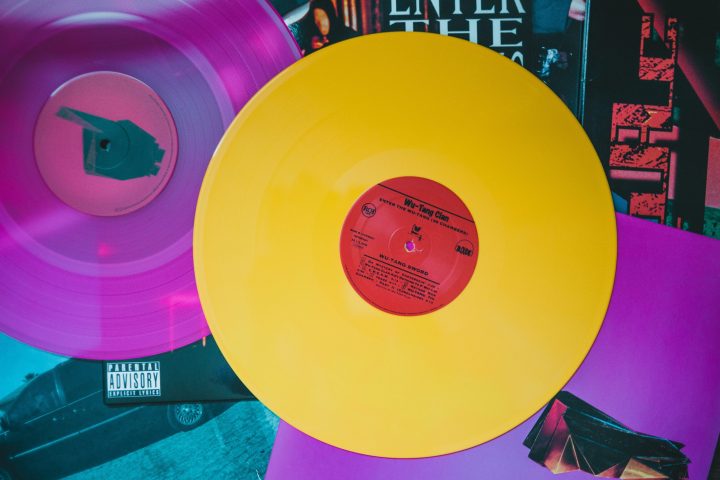
Still, there are almost infinite possibilities with regard to coloring, and you are likely to find these flying flags on releases past and present. It is rather common, in fact, for reissues of albums to feature colored discs remastered from original tapes, pressed onto a related color to the cover of the album. I recently picked up a reissue copy of Suicide’s debut self-titled record whose disc was the same red as the blood on the album cover itself. Nice!
This often makes for a great collectible experience, or can even be a way to abuse your fanbase just that bit more. The industrial hip-hop group Death
Grips, for example, are known for having a rather sado-masochistic relationship with their fanbase, even going so far as to print their records on clear vinyl, making it near impossible to play a specific song from the middle of the album, difficult as it is to see the grooves on such a record.
What Types of Records Are There?
While there are certainly many different types of records, coming in many different shapes, sizes, and colors, the answer to ‘what are vinyls’ often comes in two forms, with three answers each.
‘What are Vinyls?’ – Speed
The first point to mention is the fact that there are several speeds at which these vinyl records are typically played. These days these speeds tend to boil down to just two, though there are some turntables that give you the ability to fine-tune the speed at which a record is played, giving you far more possibilities than simply these two (33 1/3 rpm and 45 rpm).
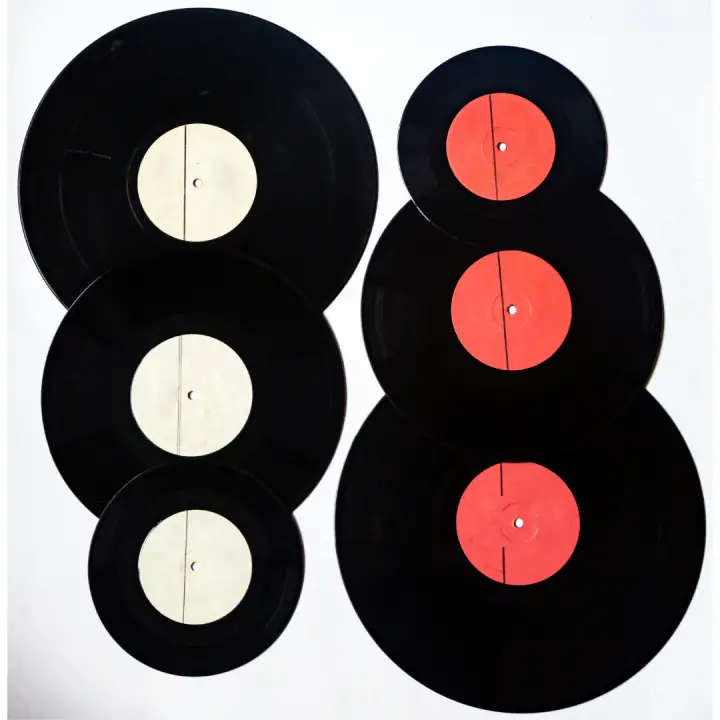
A turntable spins, clearly, and this spinning is measured in speed as revolutions per minute. There are typically only two speeds like this, as elucidated above, though some more specialist and high range turntables offer the ability to play at 78 rpm, just as would have been popular at the dawn of the record industry.
‘What are Vinyls?’ – Size
Just as there are variations in the speeds at which records are played, there are also different vinyl record types in the form of their very size and shape.
12 inch records
12-inch records will more often than not house a recording of an album, typically one half allotted per side of the physical disc. It is more often the case, also, that these albums will be played at 33 1/3 rpm, as this means there is more space on the record to contain the music which is being released in this longer form, able as a record is to hold roughly 15 to 22 minutes of music per side.
10 inch records
10 inch records are one of the rarer types of record that you will encounter in the wild, excusing those kind of novelty or limited edition records mentioned previously, and one of those types of records that, as a guide to vinyl record types, I can safely you won’t see as much of as its 12 inch and 7 inch brethren.
7 inch records
7 inch’s are the smallest of the more common vinyl record sizes, this lack in size ought not translate to an overall lack of presence, for they can be found everywhere. Typically played at 45 rpm for the sake of audio quality, they are the perfect size for holding a single song on each side (depending on the length of the songs in questions of course), able to capture 4 to 6 minutes on each side, with the run time increasing to around 7 minutes if played at 33 1/3 rpm.
Final Tones
So, there you have it! Hopefully this short but meaty guide has been helpful in elucidating for you just what are vinyls, in a time where words can metamorphose and altogether eschew their meaning entirely at the drop of a selfie.
FAQs What Are Vinyl Records
What is the difference between a record and a vinyl?
Within the context of buying and selling records, these terms are often used interchangeably to mean the same thing, so technically yes, they are the same. However, their linguistic roots come from different places entirely. Whereas vinyl originally referred to the material from which vinyl records are constructed, the term record refers to the act of recording and the fact that the discs have been recorded onto in the first place. It is easy to see how these two terms have come to mean more or less the same thing.
What is special about vinyl records?
We live in a climate of nostalgia, for all things old and antiquated, and to me this seems as much in reaction to the difficulty of our own times as any other reason a scholar might suggest to the contrary. The youth of today, faced with complexity of the present day, are looking for more and more ways to escape, to hark back to a time when things were supposedly simpler. Vinyl offers one such escape, to play act in a time that they did not originally live in, to be nostalgic for a time they never knew.
What is meant by vinyl records?
The vinyl discs themselves are made from polyvinyl chloride heated to the point where it is malleable enough to be printed with whatever is so desired. These tend to be printed with a master disc, which has itself been printed from a master tape recording or some other such medium. Vinyl recording is such an imperfect and bizarre medium that many allowances and factors have to be taken into account when mastering and mixing a song for this purpose.
What are vinyl records used for?
Once the vinyl record has been printed, then it is placed on the turntable, upon whose platter it spins and greets the stylus. This stylus transmits all of the fine detail and sensitive data from within the small and thin grooves into sound through the stereo system and speakers (or headphones if you are so inclined). Somehow the vinyl is printed in such a way that certain vibrations are transmitted through the stylus that can then be heard as music. Thus, vinyl records are used to store music, or fruit, if the record so happens to have been upcycled.

